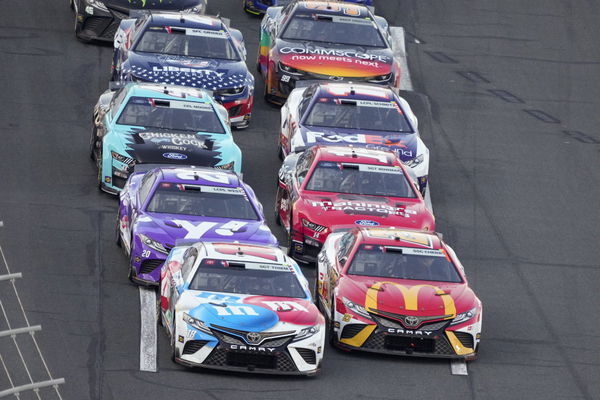Concrete vs. Asphalt: Dale Earnhardt Jr Picks His Side as He Wishes to Obliterate Every Track That Uses the Other One

Follow Us

via Getty
DAYTONA BEACH, FL – FEBRUARY 22: Dale Earnhardt Jr., driver of the #88 Nationwide Chevrolet, speaks with the media without a Monster Energy NASCAR Cup Series patch on his firesuit during the Daytona 500 Media Day at Daytona International Speedway on February 22, 2017 in Daytona Beach, Florida. (Photo by Jerry Markland/Getty Images)
We have heard of dirt tracks and asphalt tracks but concrete tracks? That’s kind of unusual. Regarding global motorsports competitions, dirt, and asphalt are pretty common but running on concrete is something that very few competitions do. NASCAR is one of them and perhaps it does make the competition unique. However, legendary racer Dale Earnhardt Jr has never been a fan of those kinds of tracks and he made his thoughts clear on a recent episode of The Dale Jr Download podcast.
There are a few famous tracks in NASCAR that have concrete on their surfaces: Bristol, Dover, and Martinsville to name a few. For Martinsville, it’s only the corners. The latest Cup Series race was run on concrete and it gave fans one of the best short-track races ever. However, Junior would not hesitate to tear it up and replace it with asphalt.
Dale Earnhardt Jr blames unpredictability for his dislike of concrete
ADVERTISEMENT
Article continues below this ad
Motorsports is already one of the most dangerous sports in the world. Adding unpredictability on the track would just put the drivers in even more danger of serious injury. The reason why Dale Earnhardt Jr believes that concrete is not feasible is that it is laid in sections and in the joints between the sections, due to changes in temperatures, the concrete expands and contracts, often leaving grooves or little peaks which makes the car extremely bumpy.
“I hate concrete. I don’t think concrete should be surfaced on any of the race tracks we run on. I would dig up every concrete track right now, even the corners of Martinsville, and pave them. No hesitation,” the former Xfinity Series champion said. “When I would run at Dover, my tires would get hot and they would build air pressure and they would feel like basketballs, like they were literally bouncing across those joints. Lap 250 in the race, 80 laps into a run, tires are screaming. Massive build-up in air pressure and temperature and they felt like they were literally leaving the surface of a race track as they were jumping these joints and so, I just don’t love the way concrete feels, I don’t love the way it reacts to the tires, and I don’t love the way it’s unpredictable in terms of the groove.”
IndyCar too had a similar experience at Dover with the concrete track and it was so much of a hassle that they decided to stop racing at the track as a result. Junior indulged in that story in his podcast as well.
ADVERTISEMENT
Article continues below this ad
IndyCar’s horrible experience with the concrete track at Dover
Trending

Dale Earnhardt Jr’s Stepmother Follows Through on the Grudge, With His Legacy Also Hanging in the Balance
May 16, 2024 04:49 AM EDT

5’8” Noah Gragson Shuts Down Carson Hocevar’s “Short” All-Star Gibe in 3-Words
May 17, 2024 10:13 AM EDT

“All the Other Drivers Look Up to Me” – Cup Rookie Fires Shots at the Entire NASCAR Field Amidst the All-Star Scramble
May 17, 2024 06:25 AM EDT

“It’s Exhausting”: Dale Earnhardt Jr Exposes the Consequences of Denny Hamlin Being NASCAR’s Poster Boy
May 16, 2024 07:01 PM EDT

Rick Hendrick & Co’s Partnership with Tarnished Sponsor Triggers Bitter Outburst- “F*CK Liberty”
May 17, 2024 04:29 PM EDT
Get instantly notified of the hottest NASCAR stories via Google! Click on Follow Us and Tap the Blue Star.

Follow Us
It’s important to note here that IndyCars are a lot lighter than stock cars. The slightest disruption on track can have massive implications. So when they went to Dover many years ago and saw those concrete ridges all over the track, the organizers just weren’t having it.
“When they took Indy to Dover for the first time, they had massive issues with the joints in the concrete where it was cut. There were these little peaks and so they had to go grind all of that down. Massive grinding at Dover to get the IndyCars where they can run through smoothly. And they didn’t run there many years,” the 49-year-old revealed.
ADVERTISEMENT
Article continues below this ad
Despite his concerns, it does not seem like NASCAR is going to move away from the concrete tracks anytime soon. However, knowing his influence, his words may force them to make some changes. Are you a fan of concrete track racing? Let us know your thoughts.
Edited by:

Shivali Nathta

